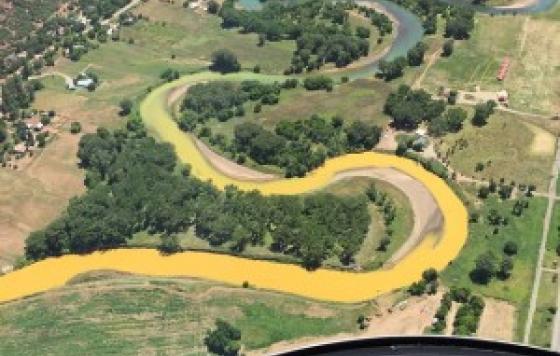By Jennifer Peters, National Water Campaigns Coordinator (Follow Jennifer on Twitter - @EarthAvenger)
Update - February 18, 2014: Click here to tell EPA to Put Drinking Water First and Protect Communities from Coal Ash!
Nearly 72-hours after a stormwater pipe buried beneath a 27-acre unlined coal ash pond burst, wastewater from the pond is still spilling into the Dan River near the town of Eden, North Carolina. Duke Energy, the pond operator, estimates that between 50,000 to 82,000 tons of coal ash has contaminated the Dan River – a volume of ash that would fill between 20 and 32 Olympic-size swimming pools. The company estimates that an additional 24-27 million gallons of coal ash wastewater has poured into the river.
Coal ash is the waste left behind from burning coal and it contains arsenic, lead, mercury, boron, cadmium, selenium, nutrients and other harmful chemicals. Heavy metals like mercury are highly soluble in water, and wastewater from ash ponds pose an especially big threat to aquatic life because these dissolved heavy metals can persist in the environment for a very long time. Heavy metals like mercury also concentrate up the food chain, which is why so many water bodies across the country have fish consumption advisories.
Despite assurances from Duke Energy and the North Carolina Department of Environment and Natural Resources that downstream water supplies remain safe, some municipal water systems are taking precautions. Virginia Beach, VA has stopped pumping water from Lake Gatson, which is fed directly by the Dan River. Lake Gatson supplies water to Virginia Beach, Chesapeake, and Norfolk.
And there should be a reason for caution – Duke Energy took more than 24-hours to publically report the pipe break and subsequent spill, which occurred on Sunday afternoon. Also, an independent journalist is reporting that the City of Danville, VA is relying solely on water sample testing carried out by Duke Energy’s private lab to back up the City’s claim that the drinking water is safe.
As of Wednesday, Duke Energy engineers were still working to stop the flow of wastewater from the coal ash pond into the Dan River. Our friends at Waterkeeper Alliance and Appalachian Voices have been on the ground monitoring the situation and collecting water samples since Monday. Another ally, Southern Alliance for Clean Energy, is compiling media coverage of the spill on its Southeast Coal Ash Waste webpage.
This spill comes five years after the catastrophic TVA spill near Kingston, TN that dumped a staggering one billion tons of coal ash slurry into nearby streams, and buried several homes in toxic ash. This latest spill underscores the need for minimum safety and public health standards to protect both human and wildlife communities from coal ash pollution. For too long, power plant companies have been allowed to dump their toxic waste in unlined ponds, many near rivers and lakes, potentially putting the drinking water supplies of millions of Americans at risk. Even Duke Energy agrees that storing coal ash in ponds is outdated technology. The Environmental Protection Agency (EPA) recently announced it will be coming out with new coal ash regulations by December 19, 2014. We will be pushing for the agency to finalize strong, federally enforceable standards to prevent disasters like this from happening in the future.
Related Posts
Stay Informed
Get the latest updates and actions:
Thanks for signing up!
There was a problem processing your signup. Please try again.


